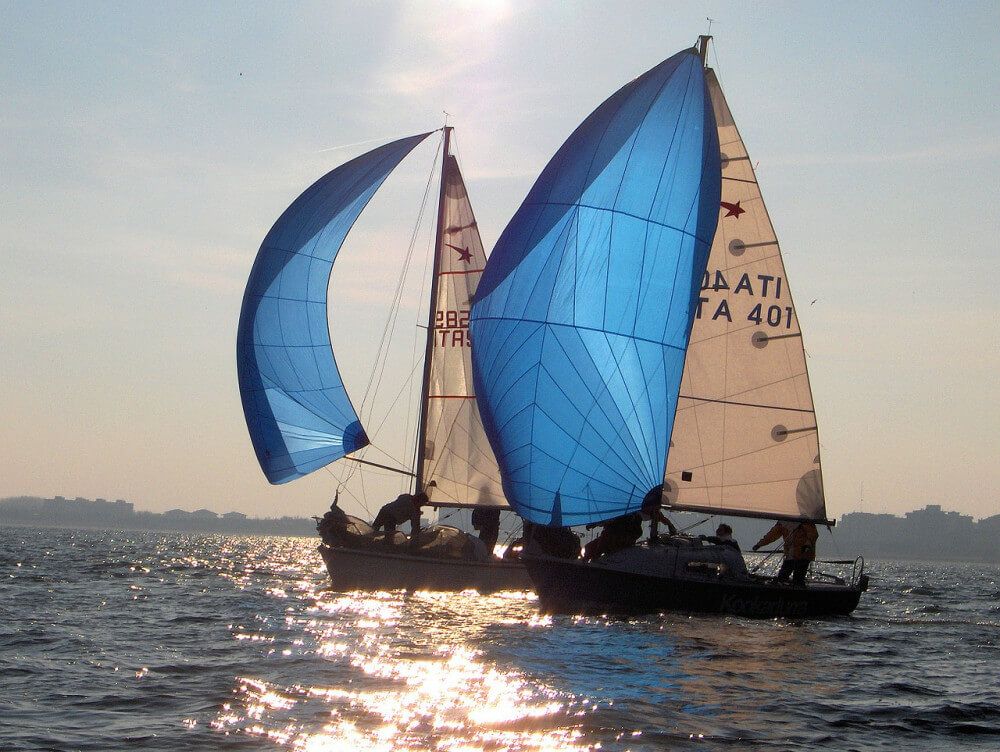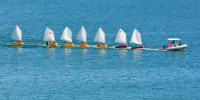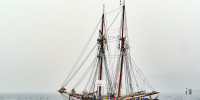How Are Sail Numbers Assigned? (And how to pick yours)
When ordering a new sail, one is confronted with the bitter truth: 'I don't know where sail numbers come from'. But neither do I - about time we find out.
How are sail numbers assigned? Sail numbers are generally assigned in consecutive order. They are assigned by either the builder, class association (for inland competitive racing), or national authority (required for offshore racing yachts). It isn't mandatory to register an official number. If you don't compete you may assign your own number.
It's simple enough I guess. If you participate in competition you do have to get it right though. In this article I'll go over the different authorities, and where you can apply for your number. If you want 5 cool ideas for your own sail number, read on till the end. But first, let's get into the math.

Who Issues Them?
There are four types of sail numbers, and they all get issued by different parties:
- Factory numbers - issued by the builder
- Class numbers - issued by the class association
- International numbers - issued by the national authority
- Creative numbers - issued by you
But before you start peeling off those numbers and apply some obscure mathematical theoru, lets make sure you get it right.
Factory numbers
The boat builder can put whatever number they like best on the sails. They use there own numbering systems, which are generally related to the build or hull number. They can reserve code blocks with the national authorities for larger offshore sailing yachts that require international registration. This way they won't have to break their neat number streak.
Class numbers
Class associations can also issue sailing numbers. For example, the International Laser Class Association (ILCA) issues numbers for laser racing, the International Optimist Dinghy Association (IODA) issues them for Dinghy, Tasar for Tasar, and so on.
They issue numbers to participate in their own races and tournaments. These are not internationally recognized, and there may be duplicate numbers across classes and countries. They may look something like this:
189882 BEL
or ...
FJ NED 775
International sail numbers
If you participate in offshore racing, or if you own an offshore racing yacht, you require international sail numbers. These are issued by your national authority. It's the fancy number with the country code as prefix. They're generally formatted something like this:
AUS 6133
or ...
GBR 4567T
Check out this great resource at Wikipedia for a complete list of country codes.
The national authorities are:
- US Sailing
- RYA (UK)
- Sailing Canada
- Australian Sailing
Creative numbers
As long as you don't sail offshore and don't happen to own a yacht that can sail in international waters, you don't actually need a sail number. Your boat probably already has a number. I bet it's a boring one. Most sailboats come with numbers applied by the builder. Good news: you may remove them. You're allowed to alter them or replace them with anything like. These tend to look as follows:
Tip: If you have a sail with a build number but are unsure if its the original one: some manufacturers scribe the build number under the drawers, seats, behind pillows and so on.
Do I Need One?
So it isn't mandatory to use sail numbers for anything on inland waters. In most countries you are required to have a hull number for identification. That's a bit like a car's registration plate. But no sail number. If you do want to have a number, it doesn't have to match your hull number.
But that changes when you enter into competition. It makes sense that the race organizers need a way to identify you. To keep it simple, let me split it up. There are only three possible scenarios:
- You don't race: you use the number issued by the builder, or make up your own
- You race on inland waters: you use the number issued by the class association
- You race offshore or own a very large yacht (good for you): you use the number issued by the national authority (RYA, USS, SC, AuS)
ISAF requires country codes for sailboats international waters. Offshore numbers are essential for all racing yachts, and also recommended by the RYA for cruisers on sea. They are very important for identifying you and help with assist an rescue situations.
The RYA actually recommends all yachts to have a unique sail number. They also issue numbers for dinghy and keelboat sail, and windsurfers as well. So if you want, you can get your official GBR code, but it will cost you, and my guess is you can come up with something way more original.
How To Get Yours
You can simply apply for a number online for a small fee - currently about 30 pounds. But this is only the registration. You have to get the actual numbers yourself from a sail-maker or chandlery (they're very cheap).
Registrating a sail number costs you anywhere between $50 - $200. In the US, registration costs you $100 - 125. In Australia: $220 AUD. Canada charges $150 CAD. The UK is actually the least expensive, at £30.00.
Canada also offers cool premium 1-digit numbers, coming in at $5,000. Be quick, only 9 left! You can also get yourself an Out of Sequence number, which is similar to the US automotive license plates. Could be great fun.
RYA: If you're a gold member, you get your number for free. Gold membership costs ... oh wait, you can only become Gold member by being a regular member for 10 consecutive years.
RYA issued sail numbers stay with the boat, even when the owner changes
RYA uses the suffixes M for monohulls and N for single-designs boats. Other than that, it's completely random.
You can apply for your numbers here:
- US Sailing (link to application form)
- RYA - UK (link to application form)
- Sailing Canada (link to application form)
- Australian Sailing (link to application form)
Some Tips on Applying Your Numbers
If you're ready to order your numbers, here are some things to consider:
- using vinyl or a cutout by a sign maker isn't a great idea - these usually fall off within a week
- the numbers use a special adhesive which can withstand water
- they are quite inexpensive so no need to cheap out
- the best numbers are sewn on, but they are more expensive (as you'd expect)
- Dacron is also good
- if you're not sure yet what you want on your sail, just order a bunch of 8s - they're easy to cut into any letter you need
5 Cool Ideas for Sail Numbers
- number of boats you've owned
- the year Columbus discovered the Americas (1492)
- the golden ratio (16180)
- longitude and latitude of your favorite restaurant
- your debit card pin code (no one will ever guess the obvious)
Related Questions
What is the sail number font? It's generally some sort of monospace (or block font). However, each class and organization uses their own font. In the US, it's common to use multiple 8s, which are then cut to size, resulting in an extreme rectangular monospace typeface.
What material are sail numbers made of? The most used material for sail numbers and insignia is adhesive backed Dacron. Dacron is a woven polyester fabric that's incredibly strong. It's one of the favorite materials used for sails up to 40'. Thanks to the tight weave it's very durable and retains shape really well.
Did you find the answer to your specific question?
👍 10 👎 6



Comments
Karta Healy
Hello Shawn
Can you please assist me where Google has failed me? I recycle sails and have come across the biggest spinnaker I have ever handled. It has these number UAE 52. How does one go about finding out what the vessel they came from?
Must have been a big Dubai show boat!
Thanks
Karta
Leave a comment